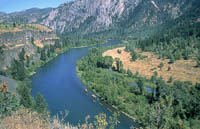Raising Missouri River: is it worse to argue with nature?
People always want to make their life more comfortable. If the nature mingles, change it. The Capt. Meriwether Lewis shaved about 240 miles off the roughly 2,600-mile Missouri River , the nation's longest, and left a straighter, deeper waterway that is easier to navigate.

But unintended consequences of the straightening and the construction of large dams in Montana , the Dakotas and Nebraska have affected not only the river but also the lives of those around it.
Reshaping the river to make it easier to navigate made it less hospitable to three animals on the federal endangered species list, including an ancient fish called the pallid sturgeon.
The U.S. Corps of Engineers, which began reshaping the river in the 1830s, is now using a process called a spring rise to artificially raise the river's water level to help the sturgeon spawn.
The spring rises, the first of which was conducted in May, have been praised by environmentalists trying to bring back the sturgeon. But they have also led to concerns up and down the river.
"We keep our eye on trying to provide a balance," notes Paul Johnston, a spokesman for the corps' northwestern division office in Omaha .
People living near the reservoirs in the river's northern sections fear depletion of the big lakes and harm to water supplies and tourism. In the river's southern basin in Missouri , some worry about flooding.
When Lewis and Clark used the Missouri to explore the American West, the river was a winding, tree-trunk infested stream that was dangerous to navigate, reports the AP.
N.U.
Subscribe to Pravda.Ru Telegram channel, Facebook, RSS!


